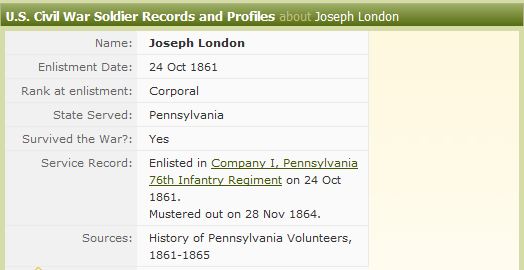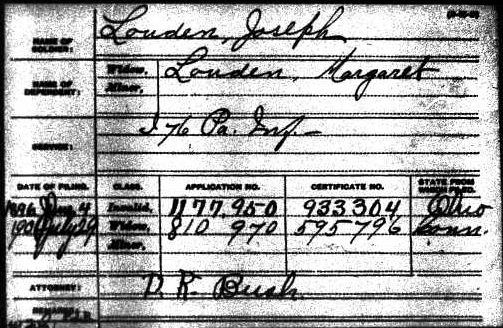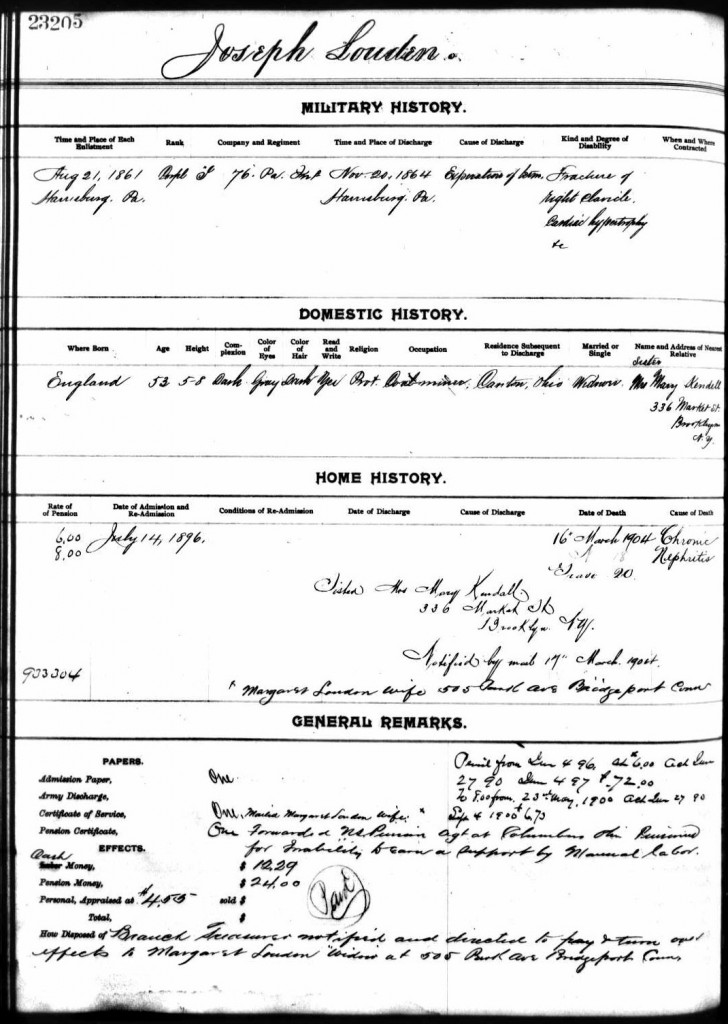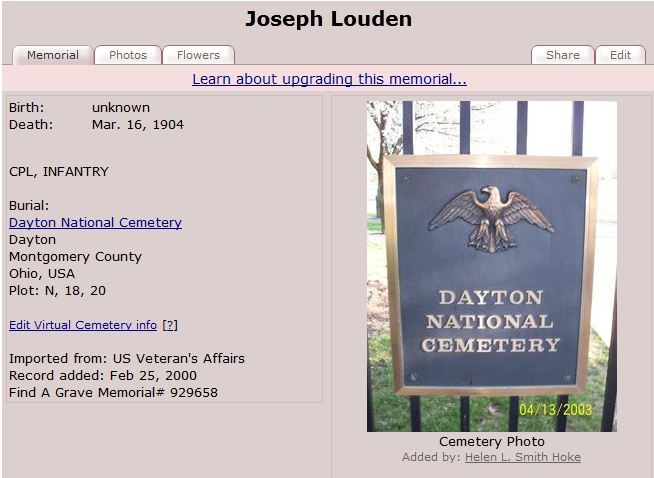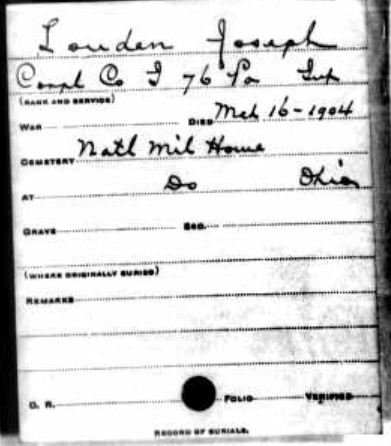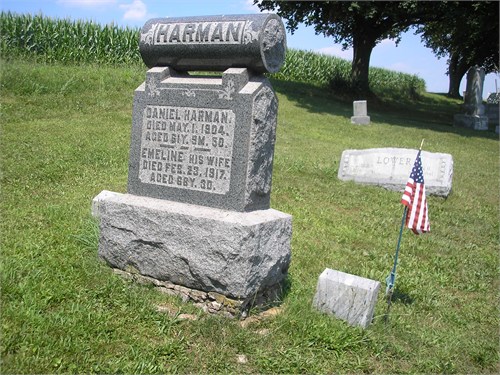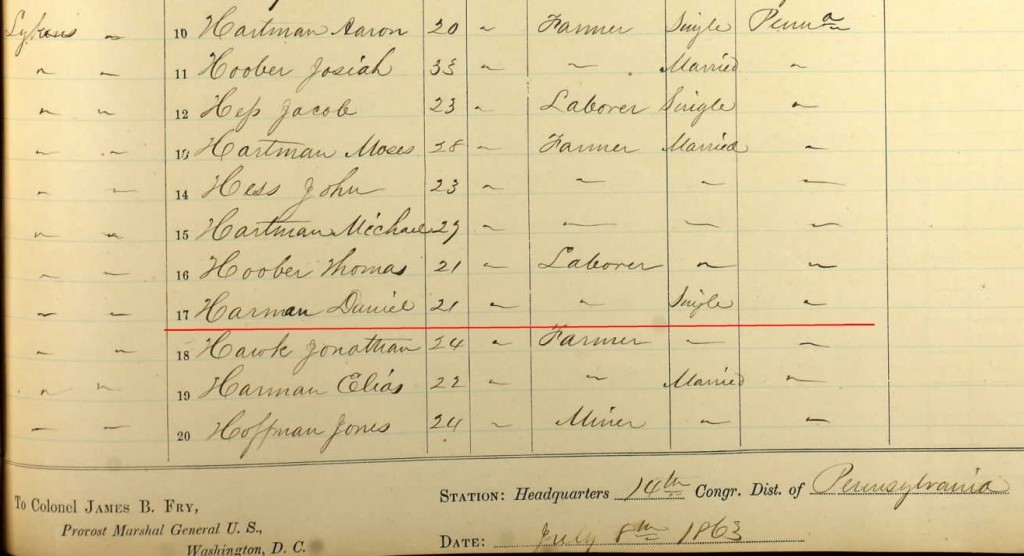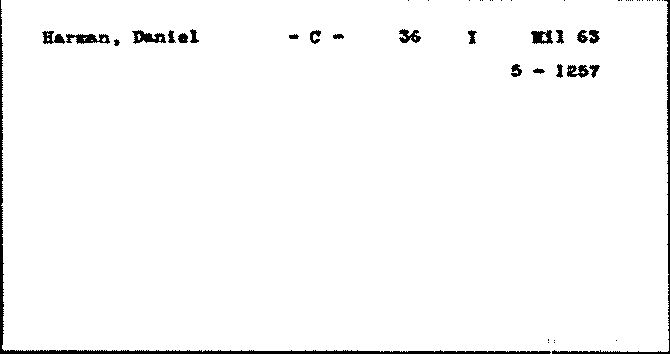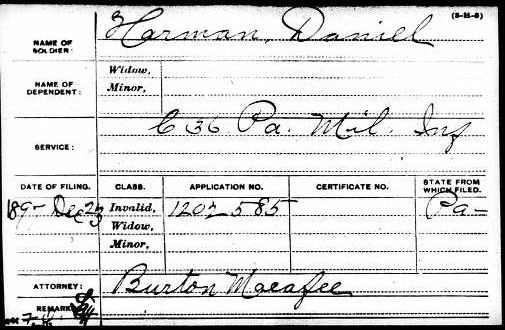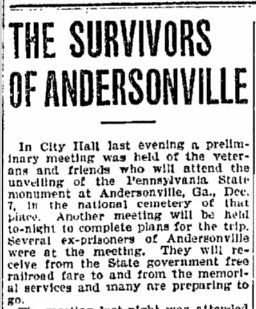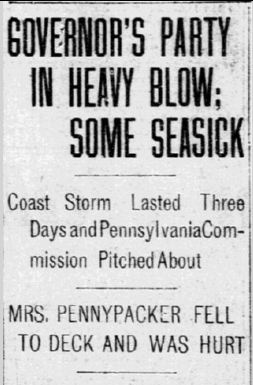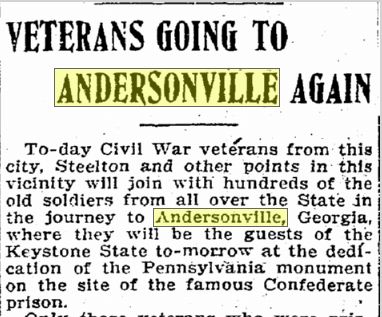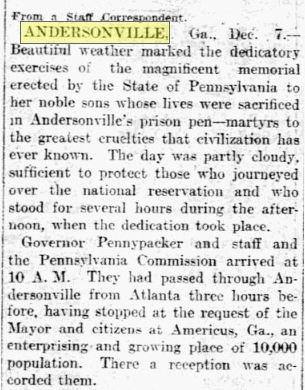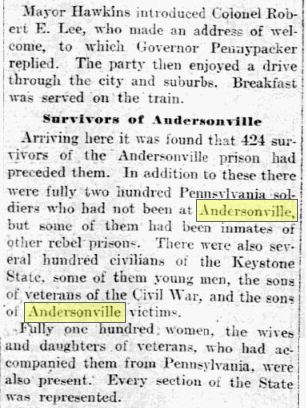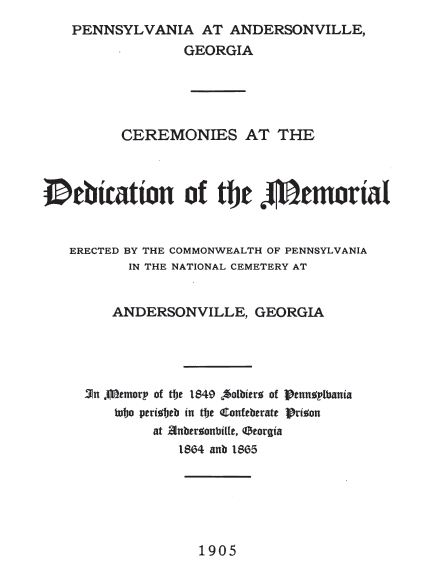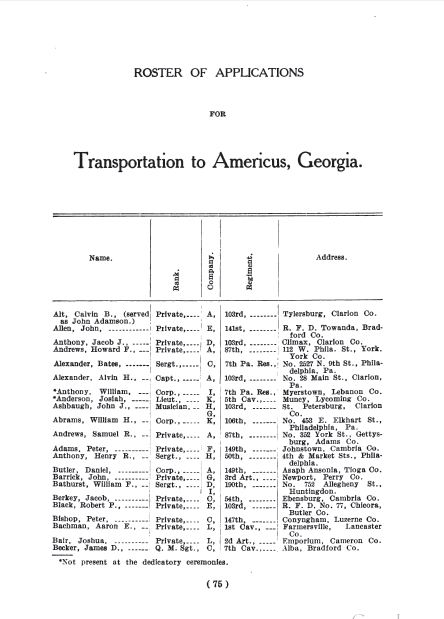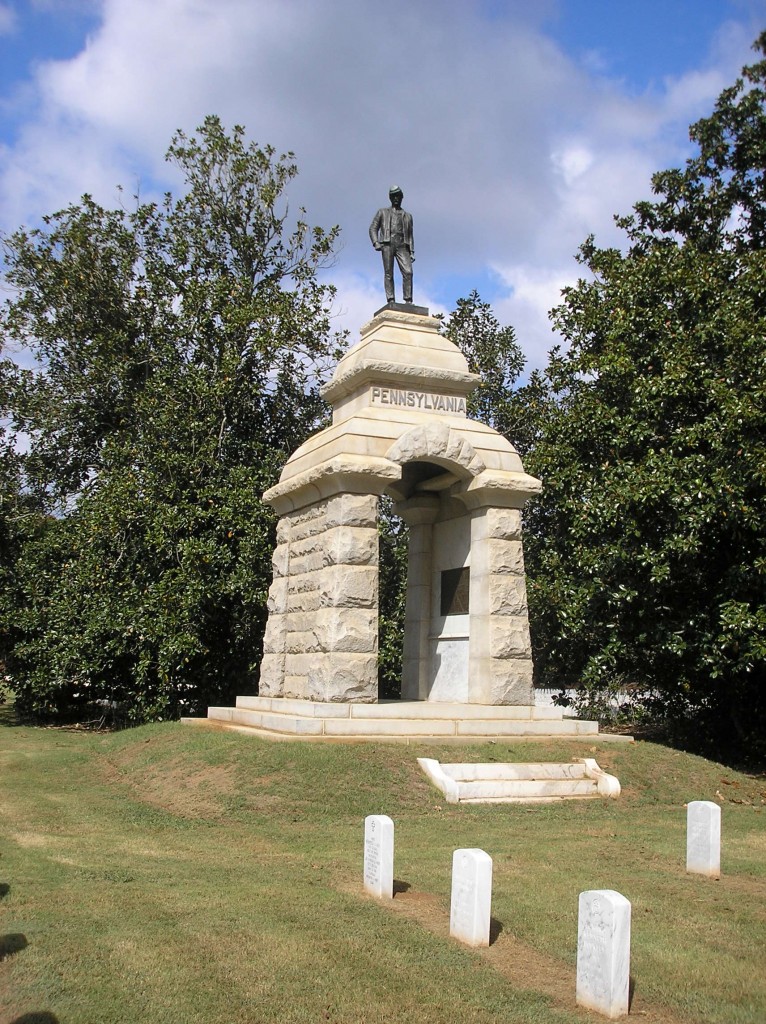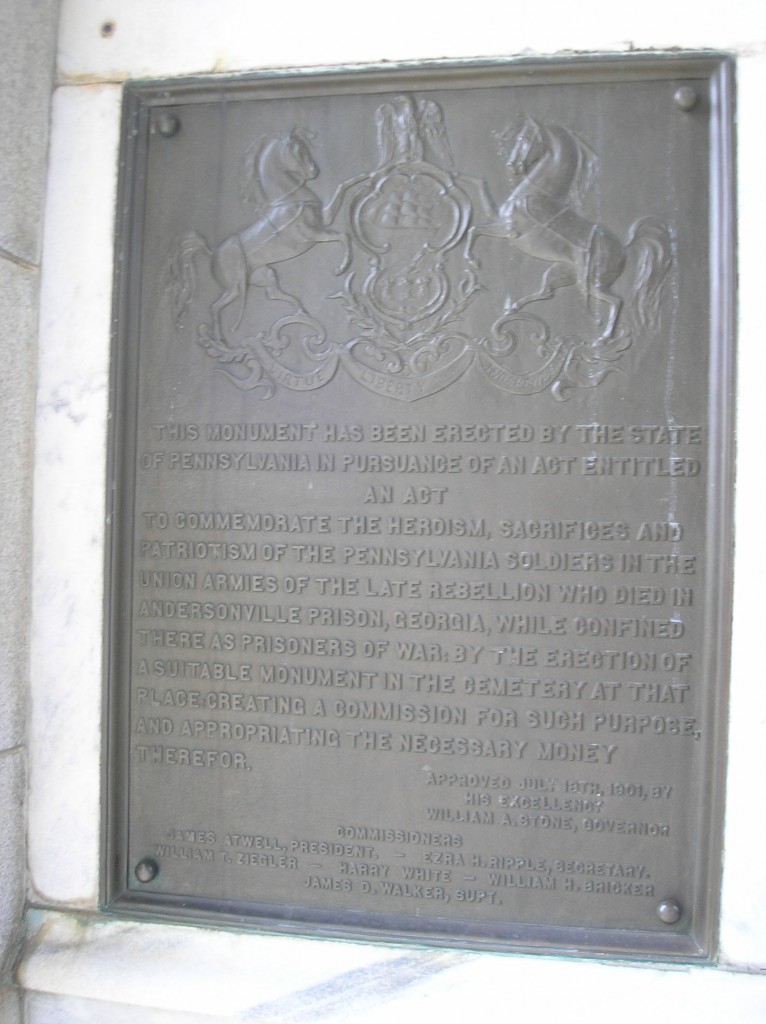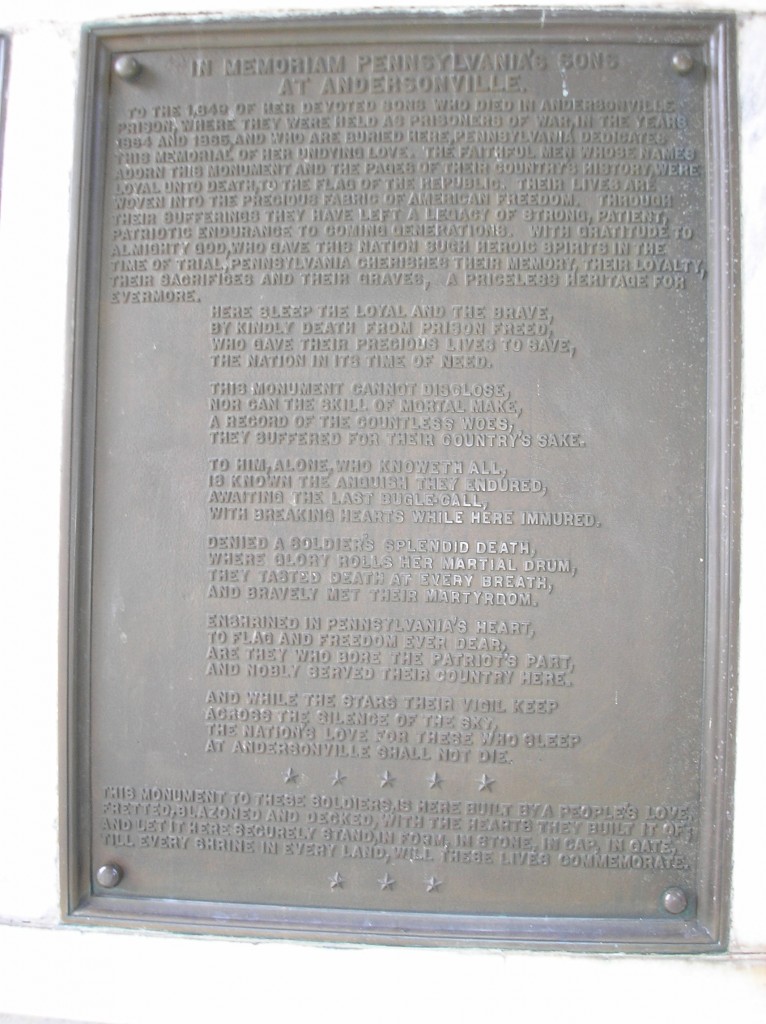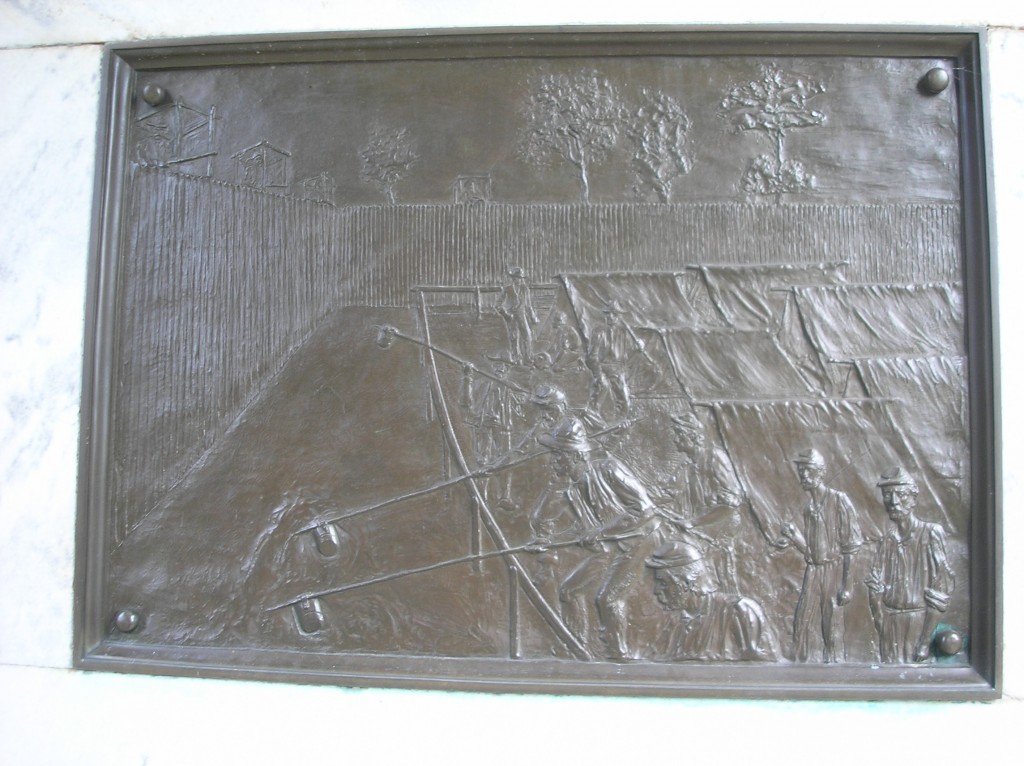Death of Joseph Louden in Soldiers’ Home in Dayton, Ohio
Posted By Norman Gasbarro on April 2, 2012
On 8 April 1904, the Lykens Standard reported the death of a former Lykens area resident, Joseph Louden, who had served with the 76th Pennsylvania Infantry, Company I, as a Private and Corporal from 24 October 1861 through 28 November 1864. The obituary indicated that the name of the deceased was “Joshua Louden” and the writer of the obituary was unable to locate the name of the regiment in which Corporal Louden served.
With the information that Joseph Louden had died in Dayton Ohio at a Soldiers’ Home, a search of military records was made on Ancestry.com and the following records were obtained:
U.S. Civil War Soldiers, 1861-1865
Name: Joseph Louden ——– Side: Union ——– Regiment State/Origin: Pennsylvania ——– Regiment Name: 76 Pennsylvania Inf. ——– Regiment Name Expanded: 76th Regiment, Pennsylvania Infantry ——– Company: I ——–Rank In: Private ——– Rank In Expanded: Private ——– Rank Out: Corporal ——–Rank Out Expanded: Corporal ——–Film Number: M554 Roll 72 [the film reference number is to the series and roll of records which provide a single index card for the veteran, such cards for Pennsylvania veterans of Pennsylvania regiments/companies available at the Philadelphia National Archives Branch Office on microfilm].
American Civil War Soldiers
Name: Joseph London ——– Enlistment Date: 24 Oct 1861 ——– Side Served: Union ——— State Served: Pennsylvania ——– Service Record: Enlisted as a Corporal on 24 October 1861. ——–
Enlisted in Company I, 76th Infantry Regiment Pennsylvania on 24 Oct 1861. ——– Mustered Out Company I, 76th Infantry Regiment Pennsylvania on 28 Nov 1864. ——–Sources: 18 [this #18 reference is to Bates, History of Pennsylvania Volunteers, 1861-1865].
U.S. Civil War Soldier Records & Profiles
Name: Joseph London ——– Enlistment Date: 24 Oct 1861 ——–Rank at enlistment: Corporal ——–State Served: Pennsylvania ——–Survived the War?: Yes ——–Service Record: Enlisted in Company I, Pennsylvania 76th Infantry Regiment on 24 Oct 1861. ——– Mustered out on 28 Nov 1864. ——– Sources: History of Pennsylvania Volunteers, 1861-1865 [this reference is to Bates]
A search was also done for “Joseph Louden” for a Pension Index Card and the following result was obtained:
The Pension Index Card confirms that the widow applied for a pension in 1904 from Connecticut (the date is difficult to read), a fact stated in the brief obituary from the Lykens Standard of 8 April 1904. The card also indicates that by 1896, when Joseph Louden applied for a pension, he was living in Ohio. It is also easy to see why his name was mistakenly reported as “London” by the transcribers of the records. The basic fact that the only service Joseph Louden reported when he applied for a pension was his service in the 76th Pennsylvania Infantry, Company I, is confirmed by the Pension Index Card.
With these elements of his military record now confirmed from information in Ancestry.com, a search was then made for “Joseph Louden” in Steve Maczuga’s Pennsylvanians in the Civil War Database. Maczuga’s database was constructed based on Bates’ spellings of the names, so no entry was found for “Louden.” Instead, this soldier was found under “Joseph London” as he was listed in the databases “American Civil War Soldiers” and “U.S. Civil War Soldier Records and Profiles” that were obtained through Ancestry.com (above).
The Bates’ spelling of the name is essential to locate the Veterans’ File Card in the Pennsylvania Archives. A search for “Joseph London” produced the following record:
From the Veterans’ Card, it is learned that Joseph Louden was 20 years old at enrollment 9born about 1841), was 5 foot, 8 inches tall, had dark complexion, hazel eyes, and brown hair, and worked as a miner. We also learn that his residence at the time of enrollment was Dauphin County, although no specific locality was given. It is also learned that Joseph Louden enrolled in York County approximately two months prior to his muster date, probably taking the Northern Central Railroad to the place of enrollment from his residence in Dauphin County. The card also notes that the “rolls” [reference here is to the actual muster rolls] spell the last name as “Lovdon” [another error, perhaps meaning “Louden”?]. The reference to Bates is “2-978” which was described in a prior post on this blog.
The Veterans’ Card also contains a disputed fact about the service of Joseph Louden – that his initial muster was as a Corporal. The database “U.S. Civil War Soldiers, 1861-1865” (above) indicates that his initial muster was as a Private. This database refers to National Archives Record Cards which index the actual muster rolls that were taken every two months for pay purposes. Therefore, it is important to first consult the National Archives Record Cards (available in Washington, D.C.) and then the actual muster rolls (available at the Pennsylvania Archives) to determine when the promotion to Corporal was actually made. The promotion could have been made fairly soon after “muster in” if the other databases and Bates report his initial muster as a Corporal. Unfortunately, at this writing, the actual National Archives Records Cards are not yet available on-line for Pennsylvania veterans, but there is a project underway, conducted by Fold-3 and the National Archives, to make these cards available. More information can also be found about this project on the Ancestry.com web site. Likewise, there are plans to make the actual Pennsylvania muster rolls available on line through the Pennsylvania Archives. At present, a collection of “Registers of Pennsylvania Volunteers” is available through the Pennsylvania Archives, but these records are secondary sources. The actual muster rolls, when produced on-line, will provide the most valuable primary resource to research to answer questions such as when promotions were actually given, when a soldier was “absent – sick” and when and why a soldier was discharged.
The “Register of Pennsylvania Volunteers” for Joseph Louden can be found at the Pennnsylvania Archives. Click here for page 1. Click here for page 2. There is no “new” information on these registers.
Since Joseph Louden died in a home for veterans, a search was made of the Ancestry.com database, “United States Home for Disabled Union Civil War Soldiers” and the following document was found:
This type of document is available through Ancestry.com for all veterans who resided in homes for veterans.
The military information is confirmed in the first category. Additional information is given about the veteran’s disability. In this case, Joseph Louden was reported as suffering from a “fracture of the right clavicle and from cardiac hypertrophy, etc.”
In the second category, “Domestic Information,” it is reported that Joseph Louden was born in England and was 53 years old at the time of his admission. Some new information is added to what was previously known. His religion was Protestant. He could read and write. He was a widower and his closest relative was his sister, a Mrs. Mary Kendall of Brooklyn, New York (see below). One conflicting piece of information about his eye color is noted – previous records indicate his eye color was hazel whereas this record indicates the eye color is gray. His residence prior to admission to the home was Canton, Ohio, a fact which conforms with the information on the Pension Index Card (above) which states that he applied for his pension from Ohio.
The information about Joseph Louden being a widower is strange in that a widow is named as a survivor in the obituary (above) and the Pension Index Card notes that a Margaret Louden applied for a widow’s pension at his death in 1904. The home record could be in error or Joseph could have re-married. More research is needed to determine why it was stated that Joseph was a widower and why his sister was named as his closest relative (see below).
The next category, “Home History” further confuses the “widower-widow” question. The date of admission to the home is given as 14 July 1896 – after the date in 1896 given as his pension application date on the Pension Index Card (above)- and the amounts of his pension allotment are given as $6.00 and $8.00, with the Pension Certificate Number given as 933304 (consistent with the Pension Index Card). But in reporting his death, there is a notation that the sister was notified, and there is notation that there was a widow, Margaret Louden, living in Bridgeport, Connecticut. The cause of death on 16 March 1904 was given as “chronic nephritis” and the “grave” notation points to burial in the home’s cemetery or in the Dayton National Cemetery.
The final category of “General Remarks” again contains the name of the “wife” as “Margaret Louden” and that the Branch Treasurer [assuming that this was the Pension Office in Canton, Ohio] was notified and directed to send all payments and effects to Margaret Louden in Bridgeport, Connecticut. Apparently, Margaret Louden and her husband, Joseph Louden, were separated, but not divorced, and although Joseph declared that he was a “widower” on admission to the home, there was no death or divorce, and legally, Margaret was entitled to her husband’s pension – which she collected until her death [a date which at this writing is unknown]. More information is sought on Margaret Louden and the reasons for her separation from her husband, as well as any legal actions she may have taken to secure her entitlement. Such information could possibly be found in the pension application files which are available at the National Achives in Washington.
Since Joseph Louden was buried in the cemetery in Dayton, a search was made of findagrave to locate a picture of his grave marker. The result of the search is as follows:
The record on findagrave confirms that Joseph Louden was buried in Dayton National Cemetery and that the information was imported from a database available at “U.S. Veterans Affairs.” However, there was no picture of his grave marker. In searching the Ancestry.com database entitled “Headstones Provided for Deceased Union Civil War Veterans,” the following card was found:
The card confirms the military service, the date of death, and the information that Joseph Louden was buried in the home’s cemetery. The card also confirms that the government provided a free headstone for the grave of Joseph Louden.
Another piece of information on the life and military service of Joseph Louden was found in the census records available through Ancestry.com. The portion of the 1880 Census sheet for Wiconisco Township, Dauphin County, is shown below:
This is the only other found reference to Joseph Louden as “Joshua Louden.” It is clearly the same person – the coal miner – and in another part of the 1880 sheet, his place of birth is identified as “England.” It is also the only primary source reference found thus far that places him in the Lykens Valley area. Children are listed as Joseph Louden, a laborer, age 12; Mary Louden , age 9; and Jane Louden, age 3. Mary and Jane (as Jennie) are listed as survivors in the obituary, and living in Connecticut at the time of their father’s death in 1904. Unfortunately, no other census returns have been located for Joseph Louden.
Lastly, there is a recognition for the Civil War service of Joseph Louden in Lykens Borough at the G.A.R. Monument which has been previously described on this blog.
Joseph Louden is named as a member of the Heilner Post G.A.R., who joined after organization, but he is incorrectly listed with the Privates, rather than with the Corporals. When the monument was created in 1925, as was described in a previous post on this blog, the person responsible for determining who should be included and who should not be included was Henry Keiser, who at the time was quite elderly, and many mistakes were made – including omissions and the entry of some dubious names. Joseph Louden had been dead for more than 20 years at the creation of this monument, and although he was legitimately included, there was apparently no one available to correct the information about his service rank. The records show that he was living in Canton, Ohio, in 1896 when he applied for a pension and admission to the soldiers’ home. When he died in 1904, he was buried in Canton, Ohio, probably having no connections at the time to the Lykens Valley area. And, as previously noted in this blog post, the widow, Margaret Louden, and Joseph’s two daughters were living in Bridgeport, Connecticut. The Lykens Standard didn’t even know the regiment in which Joseph Louden served.
Information gets lost over time and this is one of those cases where credit has to be given to the Lykens Standard (of 1904) and the Heilner Post G.A.R. for recognizing that Joseph Louden should be counted as one of the many veterans who served in the Civil War and had a connection to the Lykens Valley area. Without those two key sources, Joseph Louden would never have been included in this Civil War Research Project. How many more veterans remain to be re-discovered? Time and further research will tell.
The Gratz Historical Society is seeking more information on the life and service of Joseph Louden. Any new information contributed by readers will be added to the Civil War Research Project. Information can be added to this post [comments} by readers – or sent to the Society. The Lykens-Wiconisco Historical Society is also researching this veteran and information can be sent to Sally Reiner who has already contributed much genealogical information about the veterans who are named on the Lykens G.A.R. Monument.
 ;
;



